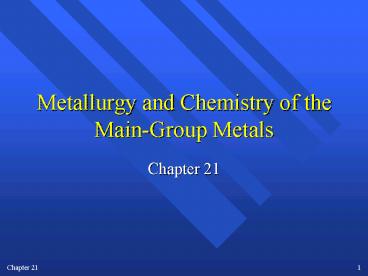Metallurgy and Chemistry of the MainGroup Metals - PowerPoint PPT Presentation
1 / 21
Title:
Metallurgy and Chemistry of the MainGroup Metals
Description:
We can also consider different atoms or. molecules using this bonding. Filled. MO's ... First write the two half reactions, PbO2 4 H 2e- Pb2 2 H2O. 2 Cl ... – PowerPoint PPT presentation
Number of Views:1289
Avg rating:3.0/5.0
Title: Metallurgy and Chemistry of the MainGroup Metals
1
Metallurgy and Chemistry of the Main-Group Metals
- Chapter 21
2
Metallurgy
- The scientific study of the production of metals
from their ores and the making of alloys having
various useful properties.
3
Metal Production
- Preliminary Treatment
- Concentration or chemical modification to
facilitate later steps. - Reduction
- Metal ions are reduced to form the free metal by
electrolysis or chemical means. - Refining
- Purification of the free metal generated by
electrolysis.
4
Metallurgy and Stoichiometry
- How many kilograms of iron can be produced from
1.00 kg of hydrogen, H2, when you reduce
iron(III) oxide?
5
Metallurgy and Stoichiometry
- How many kilograms of iron can be produced from
1.00 kg of hydrogen, H2, when you reduce
iron(III) oxide using hydrogen gas?
First balance the chemical equation,
Fe2O3 (s) H2 (g) Fe (s) H2O (g)
6
Metallurgy and Stoichiometry
- How many kilograms of iron can be produced from
1.00 kg of hydrogen, H2, when you reduce
iron(III) oxide using hydrogen gas?
First balance the chemical equation,
Fe2O3 (s) 3 H2 (g) 2 Fe (s) 3 H2O (g)
7
Metallurgy and Stoichiometry
- How many kilograms of iron can be produced from
1.00 kg of hydrogen, H2, when you reduce
iron(III) oxide using hydrogen gas?
Fe2O3 (s) 3 H2 (g) 2 Fe (s) 3 H2O (g)
Use the atomic masses and reaction stoichiometry
to solve,
8
Metallurgy and Stoichiometry
- How many kilograms of iron can be produced from
1.00 kg of hydrogen, H2, when you reduce
iron(III) oxide using hydrogen gas?
Fe2O3 (s) 3 H2 (g) 2 Fe (s) 3 H2O (g)
Use the atomic masses and reaction stoichiometry
to solve,
1 mol H2 2.016 g H2
2 mol Fe 3 mol H2
55.85 g Fe 1 mol Fe
1.00 g H2 x
x
x
9
Metallurgy and Stoichiometry
- How many kilograms of iron can be produced from
1.00 kg of hydrogen, H2, when you reduce
iron(III) oxide using hydrogen gas?
Fe2O3 (s) 3 H2 (g) 2 Fe (s) 3 H2O (g)
Use the atomic masses and reaction stoichiometry
to solve,
1 mol H2 2.016 g H2
2 mol Fe 3 mol H2
55.85 g Fe 1 mol Fe
1.00 g H2 x
x
x
1.85 x 104 g 18.5 kg Fe
10
Superconductivity
- Ceramic (ionic solid) that shows no resistance to
the flow of electric current below the critical
temperature, Tc.
Resistance
Tc
Temperature
11
Applications of High Tc Superconductors
- High Tc means greater than liquid N2 (77K)
- Electric wires
- Magnetic field maintenance
- High speed trains
- The Meissner effect
- Optical switching?
12
Molecular Orbitals in Atomic Solids Conductivity
2 atomic orbitals
2 molecular orbitals (MO)
13
Molecular Orbitals in Atomic Solids Conductivity
2 atomic orbitals
2 molecular orbitals (MO)
many MOs
14
Molecular Orbitals in Atomic Solids Conductivity
Empty MOs
Filled MOs
2 atomic orbitals
2 molecular orbitals (MO)
many MOs
15
Insulators
We can also consider different atoms or molecules
using this bonding.
Empty MOs
Empty MOs
Energy Gap
Filled MOs
Filled MOs
Insulator
Conductor
16
Goldschmidt Process
- A method of preparing a metal by reduction of its
oxide with powdered aluminum.
Cr2O3 (s) 2 Al (s) Al2O3 (l) 2 Cr (l)
?Ho -536 kJ
17
Group IVa
- Lead(IV) oxide is a strong oxidizing agent. For
example, lead(IV) oxide will oxidize hydrochloric
acid to chlorine (Cl2). Write the balanced
chemical equation for this process.
18
Group IVa
- Lead(IV) oxide is a strong oxidizing agent. For
example, lead(IV) oxide will oxidize hydrochloric
acid to chlorine (Cl2). Write the balanced
chemical equation for this process.
First write the two half reactions,
19
Group IVa
- Lead(IV) oxide is a strong oxidizing agent. For
example, lead(IV) oxide will oxidize hydrochloric
acid to chlorine (Cl2). Write the balanced
chemical equation for this process.
First write the two half reactions,
PbO2 4 H 2e- Pb2 2 H2O 2 Cl- Cl2
2 e-
20
Group IVa
- Lead(IV) oxide is a strong oxidizing agent. For
example, lead(IV) oxide will oxidize hydrochloric
acid to chlorine (Cl2). Write the balanced
chemical equation for this process.
First write the two half reactions,
PbO2 4 H 2e- Pb2 2 H2O 2 Cl- Cl2
2 e-
PbO2 4 H 2 Cl- Pb2 Cl2 2 H2O
21
Group IVa
- Lead(IV) oxide is a strong oxidizing agent. For
example, lead(IV) oxide will oxidize hydrochloric
acid to chlorine (Cl2). Write the balanced
chemical equation for this process.
PbO2 4 H 2e- Pb2 2 H2O 2 Cl- Cl2
2 e-
PbO2 4 HCl PbCl2 Cl2 2 H2O
With 2 Cl- added to both sides, the balanced
equation contains both HCl and PbCl2.

